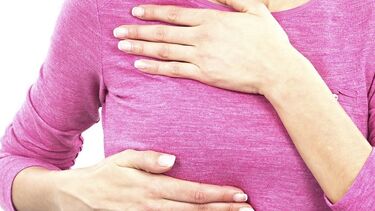
Getting to know your breasts is an important part of your health care – and it doesn’t have to be complicated. In this Q&A, general practitioner and breast health expert Dr Alia Kaderbhai (pictured below) walks you through some of the easiest ways to be breast aware, including how to do a simple self-check.
Dr Kaderbhai: Everyone’s breasts look and feel different. For some, it’s normal to have lumpy breasts or for one breast to be larger than the other.
When you’re breast aware, you know what looks and feels normal for you. This is important because if changes that aren’t normal for you occur, they can be easier for you to spot and share with your doctor.
Dr Kaderbhai: Early adulthood is a great time to start empowering women. By then, most females have finished puberty and formed breast tissue.

Dr Kaderbhai: It’s really about what works for you. Get to know your breasts by looking at and feeling them regularly. You can do this anywhere at any time, for example, while showering, moisturising, dressing or looking in the mirror.
Just remember that what’s normal for you mightn’t be normal for someone else. And if you notice any changes, make an appointment with your doctor.
Dr Kaderbhai: There are a few steps that you can follow:
The key take-home point is to get any new or unusual breast symptoms checked by your GP.
Dr Kaderbhai: Anything new or unusual for you is worth a trip to your GP. It might be a new lump in your breast or armpit; breast pain, thickening or swelling; a new rash, skin irritation or dimpling; a change in breast size; redness, flakiness or pain in the nipple area; nipple discharge or a newly inverted nipple.
Be mindful that breast size and shape can naturally change with age and different life stages. For women who are still menstruating [having periods], it’s common for breasts to become tender and lumpy at certain times in their cycle.
During breastfeeding, blocked ducts and milk blebs [clogged nipple pores] can cause lumpiness. And, by the time a woman has gone through menopause, the breasts have usually become completely soft due to changes in the tissue. This can make normal lumps more noticeable.
The key take-home point is to get any new or unusual breast symptoms checked by your GP.
Dr Kaderbhai: Most lumps don’t end up leading to a diagnosis of breast cancer. For example, common causes of lumps are a cyst or fibroadenoma – both non-cancerous.
That said, some lumps are concerning, so it’s important to visit your doctor if you notice anything new.
Dr Kaderbhai: Absolutely. Breast screenings [also called mammograms] are an important tool that can help pick up breast cancers early, before you can see or feel them. BreastScreen Australia invites all women aged 50 to 74 for a free screening every 2 years. You might need screening earlier or more often if you’re at increased risk, so talk to your doctor if you’re unsure.
Remember, regular screenings don’t replace being breast aware. Also, if you have a mammogram that’s clear and then notice a breast change before your next screening, it’s important to tell your GP.

Up to date with your health checks? Find out now with Her Health Check.
Dr Kaderbhai: Although some things are out of our control, like ageing and family history, there’s lots we can do to lower our risk.
Try to maintain a healthy weight by eating well and exercising regularly. Limit your intake of alcohol, and take steps to quit or avoid smoking.
If you’ve given birth, breastfeeding is encouraged if it works for you.
Also, if you’re having trouble adopting healthy habits, talk to your GP as help is available.
Dr Alia Kaderbhai is a Melbourne GP and specialist advisor for BreastScreen Victoria. She is also Chair of the Breast Medicine Network for the Royal Australian College of General Practitioners.
All reasonable steps have been taken to ensure the information created by Jean Hailes Foundation, and published on this website is accurate as at the time of its creation.
© 2026 Jean Hailes Foundation. All rights reserved. This publication may not be reproduced in whole or in part by any means without written permission of the copyright owner. Contact: licensing@jeanhailes.org.au